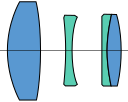The term Tessar is typically used in reference to a specific lens design that uses four elements in three groups, with the last two elements cemented into a doublet.
The original Tessar design was developed by Paul Rudolph in 1902 while he was working at Zeiss in Germany. The Tessar is one of the most frequently used optical designs throughout the history of lensmaking.
The Tessar design has a number of advantages. Firstly, it typically is a relatively sharp lens that (especially for its day) was remarkably free of major optical aberrations. Secondly, with its relatively low element count, it was a relatively cheap lens to manufacture. Also its low group-count meant it had a low number of air-glass -interfaces – something that was significant in the age before the widespread use of lens coatings. Finally, due to its design, the lens can be focused either by moving the entire objective/lens assembly (referred to as ‘unit focusing’), or simply by moving the front lens. While the later approach may lead to minor image degradation, that offers a way to focus which is both cheap to implement and necessitates very little movement.
But the Tessar design is not without faults. Most prominent of these is that Tessar-type designs rarely are exceptionally fast lenses. Typically the maximum aperture of a Tessar-type normal lens is f/2.8.
n.B! While ‘Tessar’ may refer to a lens design, the name is today also often used in various optical lenses which share nothing with the original lens design.
« Back to Glossary Index